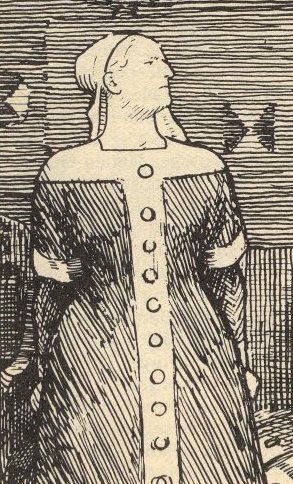Sigrid as the beautiful but vengeful daughter of Skogul-Tosti, a powerful Swedish nobleman. As widow of Eric the Victorious, she held many great estates, and was living with her son Olav the Swede, when her foster-brother Harald Grenske, a king in Vestfold sought her hand. She had him and another royal wooer, Vissavald of Gardarik, burned to death in a great hall following a feast to discourage other suitors.
She next refused Olaf Trygvasson, the king of Norway, proposal after he required her to convert to Christianity. She told him to his face, "I will not part from the faith which my forefathers have kept before me." In a rage, Olaf struck her with a glove, and Sigrid calmly told him, "This may some day be thy death."
She allied Sweden with Denmark, marrying the widower Sweyn Forkbeard who had already been feuding with Olaf. Swein had sent his sister Tyri to marry the Wendish king Burislav, who had been father of Swein's first wife, Gunhild. Tyri fled and married Olaf, goading him into conflict with her brother, while Sigrid inflamed Swein against her former suitor. This shared animosity would lead to the Battle of Swold, in which Olaf fell.
Sigrid as the beautiful but vengeful daughter of Skogul-Tosti, a powerful Swedish nobleman. As widow of Eric the Victorious, she held many great estates, and was living with her son Olav the Swede, when her foster-brother Harald Grenske, a king in Vestfold sought her hand. She had him and another royal wooer, Vissavald of Gardarik, burned to death in a great hall following a feast to discourage other suitors.
She next refused Olaf Trygvasson, the king of Norway, proposal after he required her to convert to Christianity. She told him to his face, "I will not part from the faith which my forefathers have kept before me." In a rage, Olaf struck her with a glove, and Sigrid calmly told him, "This may some day be thy death."
She allied Sweden with Denmark, marrying the widower Sweyn Forkbeard who had already been feuding with Olaf. Swein had sent his sister Tyri to marry the Wendish king Burislav, who had been father of Swein's first wife, Gunhild. Tyri fled and married Olaf, goading him into conflict with her brother, while Sigrid inflamed Swein against her former suitor. This shared animosity would lead to the Battle of Swold, in which Olaf fell.
Family Members
Advertisement
Advertisement


















